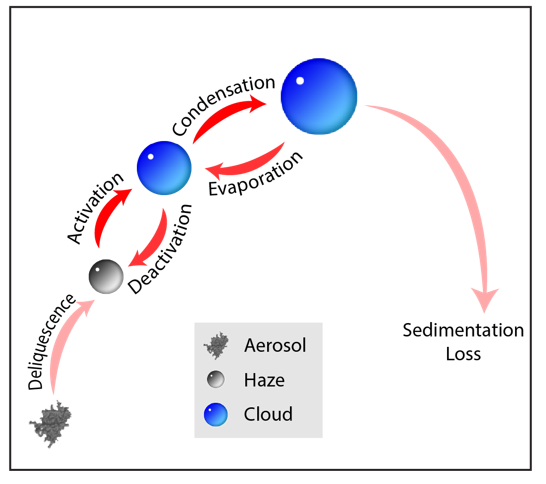Importance of representing the haze particles in convection cloud chamber simulations
Submitter
Yang, Fan — Brookhaven National Laboratory
Vogelmann, Andrew M. — Brookhaven National Laboratory
Area of research
Cloud-Aerosol-Precipitation Interactions
Journal Reference
Science
Cloud droplets develop from aerosol particles. But before an aerosol particle activates to a cloud droplet, it exists as a solution droplet, commonly referred to as haze. Most atmospheric models do not fully represent haze particles and the associated interactions with cloud droplets. By developing new microphysical models to explicitly represent haze-cloud interactions, we show that the consideration of haze particles can be crucial to correctly predict the number of cloud droplets.
Impact
Our results suggest a positive feedback loop that enhances the cloud droplet number concentration by the recycling of deactivated cloud droplets. Our study indicates that it is important to properly resolve haze particles and haze-cloud interactions for cloud chamber simulations, which is likely also true for atmospheric cloud simulations, especially under polluted conditions.
Summary
Previous large-eddy simulations of the Pi convective cloud chamber did not fully resolve the observed haze particle size distribution. Specifically, cloud droplet activation was parameterized, assuming that cloud droplets are immediately formed when the critical supersaturation for a cloud condensation nuclei is exceeded. Thus, haze particles were not represented. We developed and adapted haze-capable bin and Lagrangian microphysics schemes to fully resolve the activation and deactivation processes. Results show that haze particles formed from the recycling of deactivated cloud droplets can strongly enhance the cloud droplet number concentration in the cloud chamber, constituting a positive feedback loop. The consideration of particle curvature and amount of solute aerosol are found to be essential to predict a realistic shape of the haze particle size distribution. Our study suggests that particles and their interactions with cloud droplets may have a strong impact on cloud properties when supersaturation fluctuations are comparable to the mean supersaturation, as is the case in the cloud chamber and likely is the case in the atmosphere, especially in polluted conditions.


